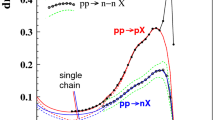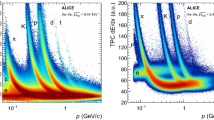Abstract
A deconfined medium of quarks and gluon, called the Quark–Gluon Plasma (QGP) is produced when heavy-nuclei are collided at relativistic energies. The QGP formation is often characterized by a phenomenon called strangeness enhancement where, the relative production of strange-to-non-strange particles are enhanced in central collisions compared to peripheral or proton-proton interactions. Besides the enhancement in K/\(\pi \) ratios, a non-monotonic energy dependence was also reported for \(\bar{\Lambda }\) to \(\bar{p}\) ratios at CERN SPS, attributed to a signature for the strangeness enhancement as well. As anti-particles are produced directly from the reaction, the \(\bar{\Lambda }\)/\(\bar{p}\) ratios are considered as a cleaner probe for the strangeness enhancement. However, at this energy range hadronic interactions have a dominant role to play and, importantly for \({\bar{\Lambda }}\) and \({\bar{p}}\), processes like baryon-anti-baryon (\(\textrm{B}{\bar{\textrm{B}}}\)) annihilation can have a significant impact. In this work, we use a hadronic transport model UrQMD, to investigate the role of baryon-anti-baryon (\(\textrm{B}{\bar{\textrm{B}}}\)) annihilation on \(\Lambda \), \(\bar{\Lambda }\) hyperon production and its effect on \(\bar{\Lambda }\)/\(\bar{p}\) ratios. The UrQMD calculations that include \(\textrm{B}{\bar{\textrm{B}}}\) annihilation can produce the trend of average transverse mass spectra for \(\Lambda \) and \(\bar{\Lambda }\), as well as, the characteristic enhancement in \(\bar{\Lambda }\)/\(\bar{p}\) ratios in data as a function of centrality and collision energy. Furthermore, \(\bar{\Lambda }\)/\(\bar{p}\) ratios extracted from the feed-down corrected SPS data are seen to be in good agreement with UrQMD model calculations with \(\textrm{B}{\bar{\textrm{B}}}\) annihilation. This suggests that \(\bar{\Lambda }\)/\(\bar{p}\) enhancement is not necessarily because of strangeness enhancement and \(\textrm{B}{\bar{\textrm{B}}}\) annihilation has a significant role to play.









Similar content being viewed by others
Data availability statement
This manuscript has no associated data or the data will not be deposited. [Authors’ comment: This paper uses UrQMD event generator with specific settings and experimental data points that are publicly available. In case the data are required, we can provide the same upon request to the corresponding author.]
References
F. Karsch, E. Laermann, P. Petreczky, S. Stickan, I. Wetzorke, 2001 Proccedings of NIC Symposium (Ed. H. Rollnik and D. Wolf, John von Neumann Institute for Computing, J ulich, NIC Series, vol.9, ISBN 3-00-009055- X, pp.173-82,2002)
M. Cheng et al., Phys. Rev. D 77, 014511 (2008)
I. Arsene et al., BRAHMS Collaboration. Nucl. Phys. A 757, 1 (2005)
B.B. Back et al., PHOBOS Collaboration. Nucl. Phys. A 757, 28 (2005)
K. Adcox et al., PHENIX Collaboration. Nucl. Phys. A 757, 184 (2005)
J. Adam et al., STAR Collaboration. Nucl. Phys. A 757, 102 (2005)
Berndt Müller, Jürgen. Schukraft, Bolesław Wysłouch, Ann. Rev. Nucl. Particle Sci. 62, 361–386 (2012)
J. Rafelski, B. Muller, Phys. Rev. Lett. 48, 1066 (1982)
Z.W. Lin, C.M. Ko, Phys. Rev. Lett. 89, 202302 (2002)
D. Molnar, S.A. Voloshin, Phys. Rev. Lett. 91, 092301 (2003)
R.C. Hwa, C.B. Yang, Phys. Rev. C 67, 064902 (2003)
R.J. Fries, B. Muller, C. Nonaka, S.A. Bass, Phys. Rev. Lett. 90, 202303 (2003)
V. Greco, C.M. Ko, P. Levai, Phys. Rev. Lett. 90, 202302 (2003)
Jun Song, Xiao-feng Wang, Hai-hong Li, Rui-qin Wang, Feng-lan Shao, Phys. Rev. C 103, 034907 (2021)
M. Mitrovski et al., NA49 Collaboration. J. Phys. G: Nucl. Part. Phys. 32, S43 (2006)
S. Hamieh, K. Redlich, A. Tounsi, Phys. Lett. B 486, 61 (2000)
A. Tounsi, K. Redlich, J. Phys. G: Nucl. Part. Phys. 28, 2095 (2002)
B.I. Abelev et al., STAR Collaboration. Phys. Rev. C 81, 024911 (2010)
M.M. Aggarwal et al., STAR Collaboration. Phys. Rev. C 83, 024901 (2011)
J.L. Klay et al., E895 Collaboration. Phys. Rev. C 68, 054905 (2003)
L. Adamczyk et al., STAR Collaboration. Phys. Rev. C 96, 044904 (2017)
W. Cassing, A. Palmese, P. Moreau, E.L. Bratkovskaya, Phys. Rev C. 93, 014902 (2016)
F. Antinori et al., WA97 Collaboration. Eur. Phys. J. C 11, 79 (1999)
F. Antinori et al., NA57 Collaboration. J. Phys. G 32, 427 (2006)
C. Alt et al., (NA49 Collaboration) Phys. Rev. Lett. 94, 192301 (2005)
Huan Z. Huang, J Phys. G: Nucl. Part. Phys. 30, S401 (2004)
C. Alt et al., (NA49 Collaboration) Phys. Rev. C 78, 034918 (2008)
B.B. Back et al., (E917 Collaboration) Phys. Rev. Lett. 87, 242301 (2001)
G.S.F. Stephans et al.,(E859 Collaboration), J. Phys. G, Nucl. Part. Phys. 23, 1895 (1997)
T.A. Armstrong et al., E864 Collaboration. Phys. Rev. C 59, 2699 (1999)
J. Gunther (for the NA35 Coll.), Nucl. Phys. A 590:487c (1995)
C. Alt et al. (NA49 Collaboration), arXiv:nucl-ex/0512033v2 (2006)
P. Koch, B. Muller, J. Rafelski, Phys. Rept. 142, 167 (1986)
E. Seifert, W. Cassing, Phys. Rev. C 97, 044907 (2018)
Fuqiang Wang, Marlene Nahrgang, Marcus Bleicher, Phys. Rev. C 85, 031902(R) (2012)
M. Bleicher et al., J. Phys. G: Nucl. Part. Phys. 25, 1859 (1999)
J. Steinheimer, J. Aichelin, M. Bleicher, and H. St\(\ddot{\rm o\it }\)cker, Phys. Rev. C 95, 064902 (2017)
Yinghua Pan, Scott Pratt, Phys. Rev. C 89, 044911 (2014)
Oscar Garcia-Montero et al., Phys. Rev. C 105, 064906 (2022)
S.A. Bass et al., Prog. Part. Nucl. Phys. 41, 255–369 (1998)
F.E. Close, Introduction to Quarks and Partons (Academic Press, London, 1979)
D.H. Perkins, Introduction to High Energy Physics, (Addison-Wesley, 1987), 3rd edition
J. Adam et al., STAR Collaboration. Phys. Rev. C 102, 034909 (2020)
T. Anticic et al., NA49 Collaboration. Phys. Rev. Lett. 93, 022302 (2004)
E. Schnedermann, J. Sollfrank, U. Heinz, Phys. Rev. C 48, 2462 (1993)
Acknowledgements
This research has used resources of grid computing facility at Variable Energy Cyclotron Centre (VECC), Kolkata. Authors would like to acknowledge discussions with Prof. Steffen A. Bass on baryon-anti-baryon annihilation in UrQMD.
Author information
Authors and Affiliations
Corresponding author
Additional information
Communicated by Che-Ming Ko.
Rights and permissions
Springer Nature or its licensor (e.g. a society or other partner) holds exclusive rights to this article under a publishing agreement with the author(s) or other rightsholder(s); author self-archiving of the accepted manuscript version of this article is solely governed by the terms of such publishing agreement and applicable law.
About this article
Cite this article
Nandy, E., Chattopadhyay, S. Impact of Baryon anti-Baryon annihilation on hyperon (\(\Lambda \), \(\bar{\Lambda }\)) production and apparent strangeness enhancement in \(\bar{\Lambda }/\bar{p}\) in heavy ion collisions at SPS energy. Eur. Phys. J. A 58, 199 (2022). https://doi.org/10.1140/epja/s10050-022-00856-x
Received:
Accepted:
Published:
DOI: https://doi.org/10.1140/epja/s10050-022-00856-x




